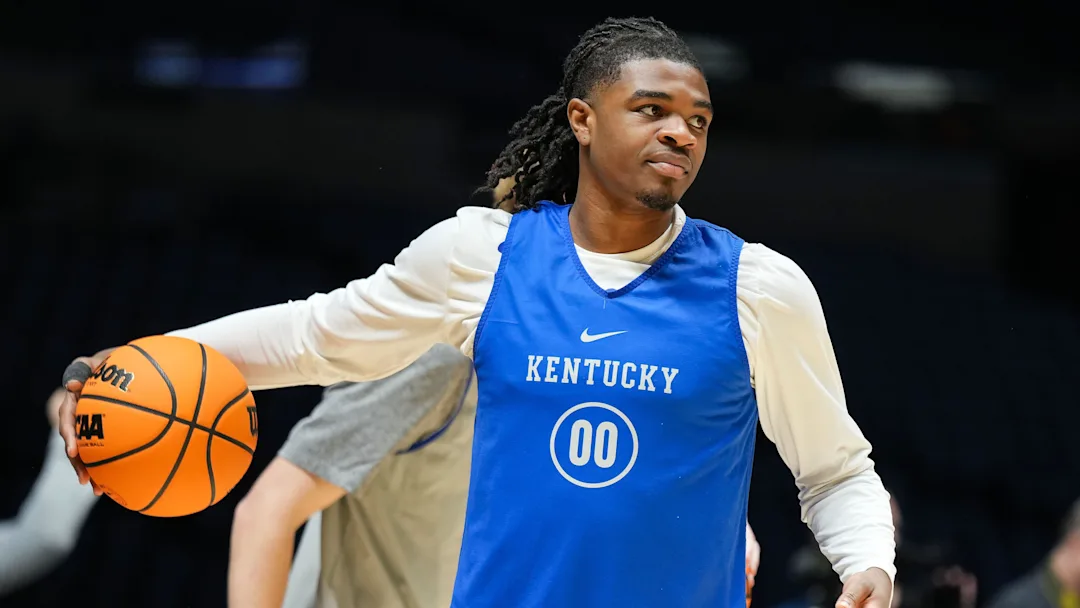Will Otega Oweh electrified the college basketball landscape during his first season at Kentucky, making his presence felt as the Wildcats’ primary offensive catalyst. After transferring from Oklahoma, the 6‑foot‑4 guard averaged an impressive 16.2 points per game in the 2024–25 campaign, alongside 4.7 rebounds and 1.7 assists espn.com+15aseaofblue.com+15si.com+15. Shooting a polished 49.2 percent from the field and 35.5 percent from three, his scoring efficiency backed up his reliable scoring output on3.com.
That 16.2 PPG average positioned Oweh as a true breakout star. He consistently delivered for Kentucky, even burying clutch, game‑winning shots against Oklahoma in both late‑season matchups and the SEC Tournament . His performances didn’t go unnoticed; he was named to the All‑SEC Second Team and made history as one of just three Wildcats to return after averaging at least 16 points, 4.5 rebounds, 1.5 assists, 1.5 steals, and 0.5 blocks reuters.com+15aseaofblue.com+15aseaofblue.com+15.
Naturally, the burning question heading into the 2025–26 season—his senior year—is this: can Oweh raise that average above 16.2, potentially reaching 17–20 points per game?
Mark Pope, entering his second season as head coach, believes so. He’s praised Oweh’s “elite physicality,” offensive versatility, and his two‑way impact aseaofblue.com+11aseaofblue.com+11ukathletics.com+11. The coach emphasized areas where Oweh can ascend to the next level: getting his shot off quicker, increasing his volume (especially from three), and further refining his playmaking and defensive anticipation aseaofblue.com.
Currently, Oweh’s shooting profile leaned heavily toward driving to the basket, with only 76 of his 415 field goal attempts coming from beyond the arc espn.com+15aseaofblue.com+15si.com+15. That’s roughly 18 percent from three, meaning there’s real upside in expanding his perimeter game. If he boosts his three‑point attempt share and maintains or improves his accuracy, that could be a powerful lever for increasing his point totals.
Offseason development reports support optimism. Analysts from Sports Illustrated predict that, with improved jump‑shot rhythm and free‑throw efficiency, Oweh could comfortably hit the 20 PPG mark—while certainly not regressing si.com. SI’s Wyatt Huff goes further, projecting a modest uptick to about 17 PPG. That projection acknowledges Kentucky’s deeper, more balanced roster yet asserts that Oweh will remain the go-to option si.com.
That didn’t happen by accident. Throughout the offseason, Oweh tested NBA Draft waters, receiving encouraging feedback that he could be a second‑round pick or more si.com. But buoyed by NIL opportunities and a desire to chase a national championship, he opted to return aseaofblue.com+1ukathletics.com+1. With his draft stock strengthened, he’s now a senior leader both statistically and intangibly.
The Wildcats remain loaded around him. Kentucky returns key players such as Brandon Garrison, Collin Chandler, and Trent Noah, and adds portal recruits like Jayden Quaintance, Jaland Lowe, and Mouhamed Dioubate reddit.com+7on3.com+7lineups.com+7. While that depth could nip into Oweh’s rebounding and assist numbers (Huff anticipates slight dips), scoring volume should remain robust ukathletics.com+15si.com+15on3.com+15.
There’s also the intangible confidence from making game-winning plays. Oweh’s clutch pedigree—banking memorable late‑game buckets—suggests not only skill but also composure under fire . That reputation could translate directly into team strategy leaning on him during crunch time, affording him more scoring opportunities when it matters most.
Examining his baseline: 16.2 points over 36 games last year is nothing to sneeze at . Add in increased usage, a more refined outside shot, greater free throw dependability (he shot a solid 77.6 percent, but more attempts are always good), and early NBA Combine growth, and the floor for his average is staying flat—or modestly up.
Can he hit 20 PPG? That’s the ceiling. Sports Illustrated suggests “up to the 20 points per game area” is realistic with improved shooting mechanics and accuracy si.com. Kentucky’s roster diversity helps by creating spacing and take‑away threats that allow Oweh easier lane access or kick‑outs to open looks.
But context matters. Kentucky is projected in the top 10–15 nationally entering the season lineups.com, and with Oweh’s return they’re viewed as more of a national-title threat si.com+7lineups.com+7on3.com+7. That rotation of scoring talent means Oweh must efficiently produce to maintain volume. So even though he may average slightly fewer minutes, his role as primary scorer remains intact.
Furthermore, SEC coaching eyes are watching. Last season’s All-SEC Second-Team accolade was well-deserved, but for 2025–26 Oweh is an early contender for SEC Player of the Year and Wooden Award conversations . For that recognition, a scoring average north of 17 is almost essential.
Kentucky’s offensive philosophy under Pope favors high tempo, dynamic two-way guards—precisely Oweh’s strengths. Pop’s system emphasizes guard penetration, physical defense, and sharing the creating load, which complements Oweh’s athleticism si.com. With two years of learning the system, his comfort level will only grow.
Will defenses key on him? Undoubtedly. Oweh will face more double teams and physical adjustments, potentially lowering his efficiency or field goal attempts. But that also invites opportunities—he’s capable of drawing defenders and hitting open teammates. Even if assists tick up, the ball will still come back, reinvested.
Counting stats aside, Oweh’s shooting percentages are foundational. He made 49.2 percent of his shots overall and 35.5 percent from three si.com+1on3.com+1. If he moves those to ~37–38% from beyond the arc, slightly increases attempts, and gets his jumper off quicker, his scoring ability jumps dramatically without volume changes.
His free‑throw performance is another lever. He shot 77.6%, a fine clip. But if he draws more fouls—something physical slashers like him frequently do—an uptick in free‑throw volume could add 2–4 points per game to his average with steady or improved conversion.
Weighing all factors, the consensus from SI and SEC pundits indicates his scoring will either hold steady or rise modestly, with realistic upside to roughly 20 PPG aseaofblue.com. Much depends on offseason progress: improved shot speed, consistent release, and incorporation of a higher percentage of threes.
Kentucky’s supporting cast depth insulates against big dips to his usage, though it might cap extreme surges in volume. Still, early projections place him in the 17 PPG range as a baseline, with tipping potential if he nails the offseason goals.
When he opted to return, pundits noted his draft feedback was strong—indicating NBA readiness aseaofblue.com. Yet he chose team goals over personal timing. That maturity and intent to lead as a senior suggests that hunger will reflect in his scoring attitude.
It will also be interesting to watch his rebounding and assist numbers. Analysts anticipate a small decline in both categories due to post presence and backcourt depth—but that allows focus on efficient scoring . Less rebounding or playmaking might subtly reduce per-game contributions elsewhere, but if Oweh leans into scoring, those dips are outweighed by higher PPG.
Another intangible: his leadership role. As one of only two seniors returned this year si.comlineups.com+4ukathletics.com+4on3.com+4, the weight of leading a contender carries added pressure. Yet past clutch moments signal Oweh thrives in owning critical moments—usually reflected in spirited scoring spurts.
Will Oweh average more points this season? All signs point to yes. Given his proven baseline (16.2 PPG) and the expectation of physical and skill growth, a conservative forecast sees him closer to 17–18 PPG. Should his outside shooting improve and he accelerates his release, that number could creep toward 19–20 PPG.
In summary, Oweh has a solid scoring foundation to build on. With renewed confidence from NBA feedback, offseason dedication to shot growth, and foreground role in Kentucky’s offense, he’s primed for scoring expansion. The question isn’t if he’ll average more than 16.2, but how far he’ll climb—and whether he’ll reach elite scoring strata alongside being a national championship leader.
While no athletic projection is guaranteed, everything in Oweh’s trajectory aligns for upward movement in scoring. From physical tools to team role, from coach and media expectations to personal motivation, the stars are aligned. Expect him to push past last year’s mark—potentially smashing 18 or even 20 PPG—while targeting All‑SEC First Team or Wooden Award contention.
In modern college basketball, sustained improvement is rare—yet all bets are on Otega Oweh to be that rare case, not just matching but exceeding his breakout 16.2 average, and cementing himself as Kentucky’s premier offensive force heading into 2026 NBA Draft season.



